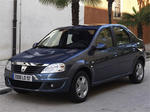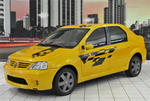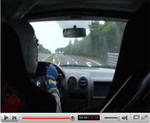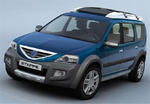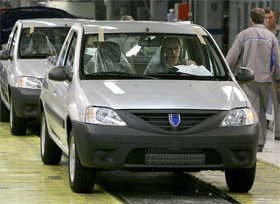
Just four years after the launch the French car maker announced today that the 1 millionth Renault Logan has been sold. The group sold more than one million units of the Renault / Dacia Logan worldwide in Logan, MCV, Van, Pickup and Sandero versions.
The newest model, the Renault / Dacia Sandero went on sale in South America at the beginning of the year and it will go on sale in Europe this month.
The production of the Dacia Logan began in Romania where the Renault opened a regional engineering and design center in order to take the design closer to its customers.
Renault Press Release:
Logan, a worldwide sales phenomenon
A fantastic lever for winning customers in new markets
The Renault Group was one step ahead of the world vehicle market when it launched the Logan program
in 2004. Designed and developed for full-markets, it significantly boosted Renault presence outside Europe and enabled the Group to enter new markets such as India and Iran. At the end of 2007, 35% of Group sales came from outside Europe, up from 22.8% in 2004.
Logan platform vehicles have been launched in 59 countries over the last four years. Some of these markets, especially Russia, India, Iran and Brazil, have extremely high potential. Logan has been successfully produced and sold in Russia since mid-2005. More than 150,000 units have been sold there, making it the best-selling
import-brand saloon in the country.
In Iran, despite a slower than expected start-up owing to industrial supply problems, Logan has since had a successful start, with more than 80,000 orders in the first week of launch in 2007.
In India, one year after the order books opened, Logan leads its field (the C-segment) with total sales of 27,603 vehicles.
In Brazil, the Group has sold 37,220 units of Logan, launched a year ago, and Sandero, launched in February 2008. In April, the two models accounted for 67% of Renault Brazil sales, which have risen by 78.6% in the last year.
Logan rapidly achieved success outside initially targeted market segments. Its unbeatable value for money and positioning as one of the lowest priced mobility options around have made it phenomenally popular everywhere, including mature western European markets (see Logan worldwide sales in the appendix). The Dacia brand became one of France’s top ten selling brands earlier this year.
Worldwide demand
In Western Europe, where the vehicle ownership rate is 521 per 1,000 inhabitants*, the Dacia brand foresaw the needs of the market and was the first to reveal the demand for low-cost vehicles. Dacia is the smart option for people looking for a new, well put-together and roomy car at an unbeatable price.
In other markets, the Logan program has met its initial objectives of making it easier for the middle classes to own a car and enabling the Renault group to establish a position in growth economies.
- In Romania (183 vehicles per 1,000 inhabitants) and the Maghreb region (Morocco: 51/1,000 inhabitants), Dacia offers the burgeoning middle classes the possibility to buy a new, comparatively prestigious vehicle that provides more comfortable mobility and higher levels of safety and reliability, thereby raising living standards and making everyday life easier.
- In India (9/1,000), Brazil (107), Argentina (145), Colombia (33) and Iran (100), Logan has mainly appealed to the upper-middle classes replacing a previous vehicle.
* Source: Global Insight figures on vehicle ownership.
Recipe for success: an original business model
The success of Logan hinges on a simple principle: customers get everything they need in a
vehicle without anything superfluous. The original inspiration behind Logan – to design a
modern, reliable and spacious car priced at €5,000 for the growing middle classes in fullgrowth
economies – has been the guiding principle ever since the project began in 1999. All
of the company’s business areas have to succeed in this challenge, which has led to an
original and profitable business model:
- Design: an optimized process oriented towards quality, cost reduction and customer
satisfaction (design to cost); the use of carry-over components from other models; economies
of scale by developing nine models (by 2012) on the same platform; and the use of digital
technology to reduce the number of physical prototypes.
- Production: assembly in competitive countries close to customers and using local sourcing
as much as possible.
- Distribution: extremely low marketing costs; an optimally adjusted pricing policy; and
distribution via existing sales structures (Dacia corner in Renault network in Europe, Renault
network outside Europe and the network of our partners – Iran Khodro and Pars Khodro in
Iran, Mahindra in India).
Sandero: a new phase in the Logan program
Renault’s ambitions with Sandero, to be sold worldwide, are the same as with Logan: win new
customers around the world, mainly in full-growth markets but also in mature ones. Sandero
was launched in early-2008 in South America and will be available from mid-2008 in Europe.
Production will begin for the Renault brand at end-2008 in Colombia (Sofasa, Medellin), and in
2009 for the Dacia brand in Morocco (Somaca, Casablanca) and for the Renault brand in
South Africa (Nissan plant, Rosslyn) and Russia (Avtoframos plant, Moscow).
2. Romania’s central role in Renault’s international development strategy
The Renault group has invested €1 billion in Romania since 1999 to renovate and develop the
Pitesti production plant, and set up Renault Technologie Roumanie (RTR) and Renault
Design Central Europe.
Pitesti, a key site in Renault’s production base
The Pitesti production site in Romania, with its vehicle plant, powertrain plant and
International Logistics Network platform, is the pilot site for the Logan program.
The vehicle plant produces the five models in the Dacia range (Logan, Logan MCV, Logan
Van, Logan Pick-up, and Sandero), spare parts for these models, and parts for the other sites
in the X90 program. Pitesti has doubled its capacity since Logan was launched in 2004, and
maximum annual production in 2009 will total 400,000 vehicles. Hourly vehicle production has
risen from 28 units in 2004 to 42 in 2006 – for Logan MCV and Logan van – to 60 in 2008 with
the arrival of Sandero and Logan Pick-up. The plant built 655,700 vehicles between 2004 and
end-April 2008.
Production at the powertrain plant, which manufactures three gasoline engines and a manual
5-speed gearbox for the Logan family and Kangoo, is also on the increase. The site boosted
output capacity from 160,000 engines and gearboxes in 2004 to 510,000 in 2007. It continues
to develop in 2008, with a new assembly line for the Alliance TL4/MT1 gearbox opened in
March (see appendix for details).
The International Logistics Network (ILN) set up in 2005 has become Renault’s largest such
centre and the biggest in the auto industry. It collects parts manufactured at the Dacia plant
and at some 200 suppliers and ships them to the seven Logan production sites. ILN shipped
the equivalent of 200,000 vehicles in 2007.
Manufactured parts are generally sourced locally. With the development of its supplier panel
in the region since the Logan production started in 2004, the local sourcing rate for Sandero is
about 60% – and a full 90% including neighboring countries such as Hungary and Poland.
The “mother” plant of the X90 program
The Pitesti plant retains its leading role in the X90 program. Production of new models starts
at Pitesti (with the exception of the Sandero start-up in Brazil), the plant produces parts for
other Renault sites that manufacture Logan, and it is also the central training platform for all
other sites producing X90 vehicles. For example:
- twenty X90 project managers and senior production workers from the Curitiba plant in Brazil
(body, paint and assembly) attended a four-week training course at Pitesti in early-2006 on manufacturing processes for B0 platform vehicles. Back in Brazil they trained production line
workers at their plant.
- in 2007, four in ten parts produced at the plant were shipped to other Renault plants
producing Logan.
Pitesti, respecting Renault standards
One of the Group’s highest quality plants
Renault Production Way (including standardized workstations with standard operations sheets
and workstation audits) and the Renault Excellence Plan (PER) are applied rigorously at all
the Group’s production sites to ensure top-level manufacturing quality. Pitesti’s quality results,
placing it in the top three Renault group plants, are the result of a major transformation begun
in 1999. The first step in this transformation was to change management and work
organization methods by reducing hierarchy to encourage personal responsibility, breaking
down organizational barriers to promote cross-functionality and shared objectives, and the
introduction of the Basic Work Team system.
Pitesti benefits from the most recent Renault standards. For example, “strike zone” facilities
were introduced on assembly lines in 2007 to make assembly operations more reliable. Parts
are pre-prepared line-side to eliminate the risk of fitting the wrong part. Every manipulation in
which production workers could choose the wrong part is monitored by computer, leaving
them free to focus on excellent fit quality.
The site has held ISO 9001 certification since 2005 and uses the Alliance Evaluation System
(AVES) to assess production quality at the end of the production line.
ISO 14001 certification since 2005
The Pitesti site was integrated in Renault’s reporting scope in 2002 and first obtained ISO
14001 certification in 2005. ISO 14001 certification, awarded by independent bodies, attests
to a site’s commitment to make continuous environmental progress and reduce the impact of
its activities on the natural world.
The site has made significant progress since 2000:
- reduction of waste by vehicle: 90% for ordinary waste, 72% for hazardous waste, 26% for
volatile organic compounds (VOCs), and 84% for discharges to water.
- reduction of energy consumption per vehicle: 86.5% for thermal energy, 75% for electricity,
and 97% for water.
Recent environmental investments at Pitesti include the modernization of the power plant
(2005) and the introduction of new water-soluble bases in the paint shop (end-2007).
Working conditions compliant with European and Renault standards
The Group policy on Health, Safety and Working Conditions implemented at Pitesti complies
with all of Renault’s standards, be they on work organization, work equipment, or protection
(footwear, glasses and gloves). Employees received an average 51 hours of training in 2007.
A “clever” site
To keep outlay costs down, Renault decided to assemble Logan family vehicles at sites with
the most competitive costs. Competitive manual labor cost is a part of the Logan’s economic
model, but not the only one. The others are as follows:
- site flexibility: the five models in the Dacia range are produced on the same assembly line, 1
km long,
- carry-over: much of the tooling used at Pitesti comes from other Group sites,
- 50% of purchasing is made from suppliers in the surrounding industrial zone, for a logistics
saving of €100 per vehicle.
Sandero, the fifth model produced at Pitesti
The Group invested €147 million to develop and produce Dacia Sandero in Europe, €65
million in study costs and €82 million in investments at the Pitesti plant. Most of the
investments were made jointly for the arrival of Dacia Sandero and the output upgrade to 60
vehicles an hour, which required an extra €100 million.
New design and engineering skills centers in Romania
With the most dynamic growth happening outside Europe, Renault’s competitive edge hinges
more than ever on close relations with local customers. This local presence allows employees
in design and engineering to gain a better understanding of the needs and driving conditions
of customers and to get local suppliers involved in design and manufacturing phases. As it did
with manufacturing, Renault is boosting the international development of its design functions,
in Romania as well as in Brazil and India.
Renault Technologie Roumanie: engineering closer to customers
Set up in June 2006, Renault Technologie Roumanie (RTR), with its 1,700 engineers and
technicians at end-2007 and nearly 3,000 by end-2009, is and will be Renault’s largest
international engineering center, ahead of those in Brazil, South Korea and India. RTR has both a local and international role. At Pitesti, it provides technical support for the plant and
suppliers. In Bucharest, engineering offices develop and adapt vehicle projects for the X90
platform and other models in Renault’s range to respond to the specific needs of customers in
the Euromed region. At the heart of the Logan production system, RTR will in the long-term
become the leading center for all platform X90 vehicles and provide technical support for all
the plants that assemble them. In addition, RTR will by end-2009 be equipped with a test
center (tracks and test benches) in Titu, 45 km from Bucharest, to boost the Group’s
capacities beyond today’s centers at Aubevoye and Lardy in France. Already, half of the
engineering of Logan Pick-up is done in Romania. The Technocentre (Guyancourt, France)
handled only the first wave, with subsequent phases managed at Pitesti, cutting design times
and costs while favoring feedback between engineering and manufacturing. RTR also carried
out some of the testing for Sandero, including tests on sealing and exposure to sunlight and
crash tests for the South American and European versions.
Design in Bucharest
The 2007 opening of Renault Design Central Europe in downtown Bucharest is a new step in
the international development of design activities, a process that started in 1999. New satellite
design centers are situated in dynamic cities with rich cultural and architectural scenes
including Barcelona (Spain), Paris (France), Seoul (South Korea), Mumbai (India), Bucharest
(Romania) and São Paulo (Brazil). These centers complement the main center at Renault’s
Technocentre in Guyancourt, France. Their diverse responsibilities include working on
automotive projects in competition with other Renault Design centers, devising creative
proposals, prospecting for business, and experimenting with new methods, techniques and
processes. The centers work independently and are staffed by the full gamut of design
professions, from vehicle stylists to manual and digital modelers, via colors and materials
stylists and graphic artists. The Bucharest Design team is made up of 15 people from six
different countries: Romania, Bulgaria, Russia, Slovenia, Canada, and France. The workforce
is expected to double in 2009.
